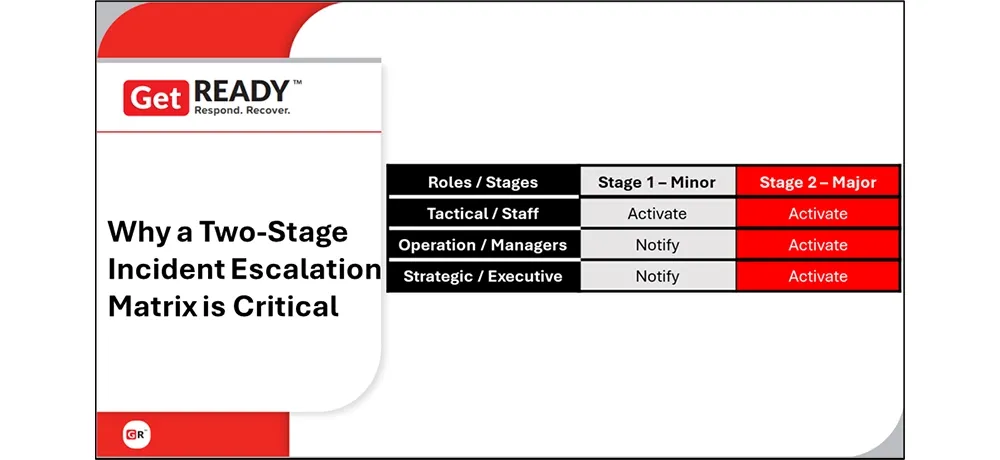Why a Two-Stage Incident Escalation Matrix is critical

Responding swiftly and effectively to emergencies is crucial for organizations across various sectors. Whether managing a hospital, overseeing municipal operations, or steering a large enterprise, having a robust emergency management plan is non-negotiable. A critical component of this plan is the 2-stage escalation matrix, a strategic tool designed to streamline response efforts and ensure that every incident is managed quickly by the making sure you have the “Right Response” with the right people and the right resources.
The 2-stage escalation matrix serves as a structured framework based on the severity of the emergency. A Stage-1 Emergency or Code is an incident that can typically be managed internally, with onsite staff and resources. A Stage-2 emergency cannot be managed internally and needs external resources like 9-1-1 Emergency Services and / or vendors to effectively manage the incident. By organizing response efforts into two distinct stages, organizations can prioritize immediate actions while simultaneously preparing for potential escalation. This dual approach not only enhances response times but also minimizes the chaos and confusion often associated with emergency situations.
Accurate Assessment and Evaluation Criteria – Risk and Response
Code Stage Assessments
Switchboard or Security dispatch assessment questions example of Code White – Violent Person
| Code White – Violent Person Assessment Questions |
Stage 1 - Minor |
|
| Stage 2 – Major |
|
Can all staff quickly assess the situation or contact Switchboard / Security Dispatch to determine the assessment criteria. For each incident or Code type there are a few simple questions and if you answer yes to any the questions for Stage 1 – and none for Stage 2 then it is automatically a Stage 1, if YES is answered for any assessment questions in Stage 2 then it is automatically given a Stage 2 priority.
By having a predefined escalation path, organizations can ensure that critical decisions are made swiftly and that resources are allocated efficiently.
Notification vs Activation
All staff and onsite vendors want to know what is going on or when a Code is activated, but they all don’t need to be involved.
Some people need to change their activity and focus on the incident while others simply need to be made aware of the situation. If the Code escalates then more people will be activated and start to have a role in the response to help manage the Code.

Benefits of Implementing a 2-Stage Escalation Matrix
One of the primary advantages of a 2-stage escalation matrix is its ability to enhance organizational resilience.
- Assessment Criteria
- The Alert System
- Notification vs Activation
- Operational status and Immediate Business Impact Assessment (IBIA) updates.
By clearly defining the roles and responsibilities of each team member, the matrix reduces ambiguity and fosters a culture of accountability. This clarity is particularly beneficial in high-stakes environments such as hospitals, aviation, energy and chemical/pharma where every second counts.
Moreover, the matrix facilitates seamless communication and coordination across departments and units.
In municipalities, for example, emergency management coordinators can use the matrix to integrate efforts across various services, ensuring a cohesive and unified response.

This integrated approach is essential for mitigating the impact of emergencies and safeguarding public safety.
Stage 1 – JAS are written specifically for the roles and actions needed in Stage 1.
Stage 2 – JAS are specific for actions people need to follow from the beginning to the All Clear. Stage 2 Code JAS are NOT simply Stage 1 JAS plus a couple extra points. Each are a complete and separate checklist.
Customizing the Escalation Matrix for Your Organization
While the core principles of a 2-stage escalation matrix are universally applicable, its implementation must be tailored to the unique needs and challenges of each organization. Customization is key to ensuring that the matrix aligns with specific roles, responsibilities, and regulatory requirements. For instance, hospitals may need to incorporate specific protocols for patient care and infection control, while municipalities might prioritize infrastructure and public communication strategies.
Organizations should also consider leveraging technology to enhance the effectiveness of their escalation matrix. Cloud-based platforms, for example, offer real-time updates and accessibility, allowing teams to respond to changing situations with agility and precision. This technological integration is particularly beneficial for safety officers and emergency coordinators, who must ensure that their plans are current and compliant with safety and privacy regulations.
Training and Practicing Code Assessments and Matrix Level Determination
Is it really a Code Stage 2 or just a Stage 1?
Practice with staff and Switchboard/Security Dispatch to ensure the Assessment criteria are easy to use, use clear simple language to prevent misunderstanding or confusion that may lead to delays. Best practice is to provide staff with “Immediate Actions” or “Upon Discovery” once the Code has been identified.
Calling the Code
Make sure your organization has a secure reliable way of sending Code Alerts and messages. Track the replies and ensure the Notifications were received.
Training and simulations also foster a culture of continuous improvement and readiness. By regularly updating and revising emergency plans, organizations can stay ahead of emerging threats and ensure that their response efforts are always aligned with best practices. This proactive approach is essential for maintaining high standards of safety and preparedness, particularly in industries where the stakes are high and the margin for error is slim.
Call the Code > Immediate Actions > Follow Code Job Action Sheets based in the Code type and Stage level.
Conclusion
Implementing a 2-stage escalation matrix is a strategic decision that can significantly enhance an organization's emergency management capabilities. By clearly defining roles and responsibilities, facilitating seamless communication, and integrating technology, the matrix provides a robust framework for responding to emergencies with precision and efficiency. As you consider implementing or refining your own escalation matrix, remember that customization, training, and continuous improvement are key to ensuring its success.



